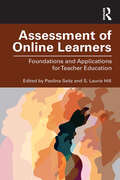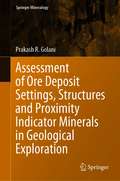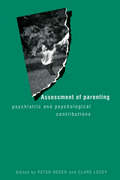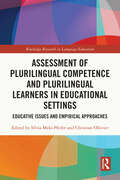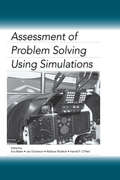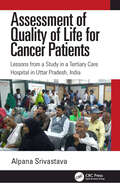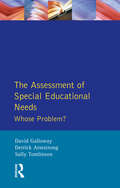- Table View
- List View
Assessment of Online Learners: Foundations and Applications for Teacher Education
by Paolina Seitz S. Laurie HillAssessment of Online Learners offers essential foundations, insights, and real-world examples for preservice teachers preparing to assess students in today’s digitized classrooms. When aligned with intended curricula and best practices, assessment not only informs but enhances both instruction and student achievement, though the recent large-scale adaptation of face-to-face learning to online platforms has yielded new challenges and responsibilities for teachers. This book explores shifts in the research and practice of assessment in online environments, the reconceptualization of course content and assessment frameworks in teacher education, the collection of fair and accurate assessment evidence reflecting students’ virtual learning, and more. Drawing from experienced Canadian instructors who overcame the inherent technological obstacles, these chapters showcase how unprecedented changes in schooling can lead to pedagogical renewal, program reevaluation, and a broader understanding of instruction and assessment practices.
Assessment of Online Learners: Foundations and Applications for Teacher Education
Assessment of Online Learners offers essential foundations, insights, and real-world examples for preservice teachers preparing to assess students in today’s digitized classrooms. When aligned with intended curricula and best practices, assessment not only informs but enhances both instruction and student achievement, though the recent large-scale adaptation of face-to-face learning to online platforms has yielded new challenges and responsibilities for teachers. This book explores shifts in the research and practice of assessment in online environments, the reconceptualization of course content and assessment frameworks in teacher education, the collection of fair and accurate assessment evidence reflecting students’ virtual learning, and more. Drawing from experienced Canadian instructors who overcame the inherent technological obstacles, these chapters showcase how unprecedented changes in schooling can lead to pedagogical renewal, program reevaluation, and a broader understanding of instruction and assessment practices.
Assessment of Ore Deposit Settings, Structures and Proximity Indicator Minerals in Geological Exploration (Springer Mineralogy)
by Prakash R. GolaniThis well-illustrated book aims to enhance observations and understanding of structural features and proximity-indicator minerals, critical in exploration. The book provides a unique blending of different content on observational and critical aspects of data acquisition, geological, structural, tectonic set-up, mineral deposit types, geophysical framework, and proximity indicator minerals. Combining these topics led to a comprehensive understanding to facilitate mineral targeting and exploration in green- and brown-field terrains. Besides field photographs, the write-up is lavishly supplemented with relevant geological and geophysical maps, tables, and case stories in field geology, making it useful for a much larger section of the geoscientific community professional geologists and geophysicists, students, teachers, and also decision-makers in geo-surveys and exploration.
Assessment of Parenting: Psychiatric and Psychological Contributions
by Peter Reder Clare LuceyThese are the sorts of questions that face mental health practitioners who are increasingly involved in complex child care cases which come before the courts. They have been given little guidance to date on how these assessments should be made, especially where a decision has to be taken as to whether a child has experienced `significant harm.' In this much needed book senior clinicians consider the principles and practice of parenting assessments and how they guide courts' decisions about children's welfare. They describe a number of frameworks for assessment and discuss the factors which help predict the risk of future maltreatment or the likelihood of successful rehabilitation. Throughout the book the emphasis is on the need to integrate the assessments of all relevant professionals in order to serve the best interests of the child, while also addressing the parents' potential to improve their caretaking skills. Offering guidance in areas of crucial significance for child, family and professional alike Assessment of Parenting will be widely welcomed.
Assessment of Parenting: Psychiatric and Psychological Contributions
by Peter Reder Clare LuceyThese are the sorts of questions that face mental health practitioners who are increasingly involved in complex child care cases which come before the courts. They have been given little guidance to date on how these assessments should be made, especially where a decision has to be taken as to whether a child has experienced `significant harm.' In this much needed book senior clinicians consider the principles and practice of parenting assessments and how they guide courts' decisions about children's welfare. They describe a number of frameworks for assessment and discuss the factors which help predict the risk of future maltreatment or the likelihood of successful rehabilitation. Throughout the book the emphasis is on the need to integrate the assessments of all relevant professionals in order to serve the best interests of the child, while also addressing the parents' potential to improve their caretaking skills. Offering guidance in areas of crucial significance for child, family and professional alike Assessment of Parenting will be widely welcomed.
Assessment of Plurilingual Competence and Plurilingual Learners in Educational Settings: Educative Issues and Empirical Approaches (Routledge Research in Language Education)
by Silvia Melo-Pfeifer Christian OllivierThis book addresses contemporary issues in the assessment of plurilingual competence and plurilingual learners. Offering theoretical and practical lenses, it contributes towards an integrated and holistic assessment of plurilingual competence and plurilingual learners. The book provides both theoretical considerations and empirical approaches around how the specificities of plurilingual learners can be considered when assessing their various competences. It covers topics relating to learners in a variety of plurilingual settings: from the education of adult immigrants, assessment of young refugees and assessment of students in school and university, to the assessment of plurilingual competence in foreign language education. Showcasing a wide range of international authors, the book provides cutting-edge research in the domain of multilingual foreign, second and heritage language assessment, and assessment of content knowledge of plurilingual students. It bridges the gap between the fields of language policies and practices, research on plurilingual competence, and assessment in language education. Providing new insights into a crucial and contentious issue, this volume will be an essential reading for researchers and postgraduate students in the fields of educational language policies, applied linguistics and multilingualism, in particular those involved in the assessment of plurilingual competence.
Assessment of Plurilingual Competence and Plurilingual Learners in Educational Settings: Educative Issues and Empirical Approaches (Routledge Research in Language Education)
by Sílvia Melo-Pfeifer Christian OllivierThis book addresses contemporary issues in the assessment of plurilingual competence and plurilingual learners. Offering theoretical and practical lenses, it contributes towards an integrated and holistic assessment of plurilingual competence and plurilingual learners. The book provides both theoretical considerations and empirical approaches around how the specificities of plurilingual learners can be considered when assessing their various competences. It covers topics relating to learners in a variety of plurilingual settings: from the education of adult immigrants, assessment of young refugees and assessment of students in school and university, to the assessment of plurilingual competence in foreign language education. Showcasing a wide range of international authors, the book provides cutting-edge research in the domain of multilingual foreign, second and heritage language assessment, and assessment of content knowledge of plurilingual students. It bridges the gap between the fields of language policies and practices, research on plurilingual competence, and assessment in language education. Providing new insights into a crucial and contentious issue, this volume will be an essential reading for researchers and postgraduate students in the fields of educational language policies, applied linguistics and multilingualism, in particular those involved in the assessment of plurilingual competence.
Assessment of Polymeric Materials for Biomedical Applications (Emerging Materials and Technologies)
by Vijay Chaudhary Sumit Gupta Pallav Gupta Partha Pratim DasThis book initiates with an introduction to polymeric materials, followed by various classifications and properties of polymeric implant material including various development methods of polymeric materials and their characterization techniques. An overview of various toxicology assessments of polymeric materials and polymeric materials for drug delivery system is also included. Design and analysis of polymeric materials-based components using Ansys software along with polymeric materials for additively manufactured artificial organs are also discussed. Features: Addresses assessment of polymeric materials in biomedical sciences, including classification, properties, and development of polymeric implants. Covers various topics in the field of tissue regeneration. Discusses biocompatibility, toxicity, and biodegradation of polymeric materials. Explores wide-scale characterization to study the effect of inclusion size on the mechanical properties of polymeric materials. Reviews limitations and future directions on polymeric material with emphasis on biocompatibility. This book is aimed at graduate students and researchers in biomaterials, biomedical engineering, composites, and polymers.
Assessment of Polymeric Materials for Biomedical Applications (Emerging Materials and Technologies)
by Vijay Chaudhary Sumit Gupta Pallav Gupta Partha Pratim DasThis book initiates with an introduction to polymeric materials, followed by various classifications and properties of polymeric implant material including various development methods of polymeric materials and their characterization techniques. An overview of various toxicology assessments of polymeric materials and polymeric materials for drug delivery system is also included. Design and analysis of polymeric materials-based components using Ansys software along with polymeric materials for additively manufactured artificial organs are also discussed. Features: Addresses assessment of polymeric materials in biomedical sciences, including classification, properties, and development of polymeric implants. Covers various topics in the field of tissue regeneration. Discusses biocompatibility, toxicity, and biodegradation of polymeric materials. Explores wide-scale characterization to study the effect of inclusion size on the mechanical properties of polymeric materials. Reviews limitations and future directions on polymeric material with emphasis on biocompatibility. This book is aimed at graduate students and researchers in biomaterials, biomedical engineering, composites, and polymers.
Assessment of Population Health Risks of Policies
by Gabriel Guliš Odile Mekel Balázs Ádám Liliana CoriAssessment of Population Health Risks of PoliciesGabriel Guliš, Odile Mekel, Balázs Ádám, and Liliana Cori, editors Public health continues to evolve as professionals work not only to prevent disease and promote well-being but also to reduce health disparities and protect the environment. To a greater extent, policy is intimately linked to this process, a reality that is gaining traction in the public health sector. With this understanding in mind, Assessment of Population Health Risks of Policies introduces an international set of guidelines, Risk Assessment from Policies to Impact Dimension (RAPID). In keeping with widely recognized models of public health operations, this innovative methodology factors in social, environmental, and economic health determinants to predict adverse outcomes to populations arising from large-scale policy decisions. Case studies from across the European Union illustrate both the intricacies of risk quantification and other components of assessment and possible relationships between policy and health outcomes. And contributors suggest how international health standards may be implemented despite significant cultural and political differences among nations. Included in the coverage: Public health, policy analysis, risk assessment and impact assessmentRisk assessment, impact assessment and evaluationTop-down versus bottom-up policy risk assessmentQuantification of health risksApplication of RAPID guidance on an international policyUse of policy risk assessment results in political decision making Assessment of Population Health Risks of Policies is an essential and proactive read for researchers and practitioners in impact assessment, public policy, public health, and epidemiology.
Assessment of Power System Reliability: Methods and Applications
by Marko ČepinThe importance of power system reliability is demonstrated when our electricity supply is disrupted, whether it decreases the comfort of our free time at home or causes the shutdown of our companies and results in huge economic deficits. The objective of Assessment of Power System Reliability is to contribute to the improvement of power system reliability. It consists of six parts divided into twenty chapters. The first part introduces the important background issues that affect power system reliability. The second part presents the reliability methods that are used for analyses of technical systems and processes. The third part discusses power flow analysis methods, because the dynamic aspect of a power system is an important part of related reliability assessments. The fourth part explores various aspects of the reliability assessment of power systems and their parts. The fifth part covers optimization methods. The sixth part looks at the application of reliability and optimization methods.Assessment of Power System Reliability has been written in straightforward language that continues into the mathematical representation of the methods. Power engineers and developers will appreciate the emphasis on practical usage, while researchers and advanced students will benefit from the simple examples that can facilitate their understanding of the theory behind power system reliability and that outline the procedure for application of the presented methods.
Assessment of Preclinical Organ Damage in Hypertension
by Enrico Agabiti Rosei Giuseppe ManciaThis book presents up-to-date information on how to assess early preclinical alterations in the heart, the small and large arteries and the kidney using the most sensitive, specific and cost-effective techniques. A wide variety of techniques are discussed, with careful attention to the latest developments. For each organ, evidence is documented regarding the prevalence of organ damage in the general and the hypertensive population. Information is provided on the potential induction of regression of organ damage by treatment, the criteria for establishing significant changes and the clinical prognostic significance of regression. The manual will be invaluable for all practitioners responsible for the clinical management of hypertensive patients, given that the assessment of early preclinical cardiovascular and renal damage permits more accurate risk stratification at baseline and facilitates evaluation of cardiovascular protection when regression of structural changes is achieved during treatment.
Assessment of Problem Solving Using Simulations
by Eva Baker Jan Dickieson Wallace Wulfeck Harold F. O’NeilThis volume explores the application of computer simulation technology to measurement issues in education -- especially as it pertains to problem based learning. Whereas most assessments related to problem solving are based on expensive and time consuming measures (i.e., think-aloud protocols or performance assessments that require extensive human rater scoring), this book relies on computerization of the major portion of the administration, scoring, and reporting of problem-solving assessments. It is appropriate for researchers, instructors and graduate students in educational assessment, educational technology, and educational psychology.
Assessment of Problem Solving Using Simulations
by Harold F. O'Neil Eva Baker Jan Dickieson Wallace WulfeckThis volume explores the application of computer simulation technology to measurement issues in education -- especially as it pertains to problem based learning. Whereas most assessments related to problem solving are based on expensive and time consuming measures (i.e., think-aloud protocols or performance assessments that require extensive human rater scoring), this book relies on computerization of the major portion of the administration, scoring, and reporting of problem-solving assessments. It is appropriate for researchers, instructors and graduate students in educational assessment, educational technology, and educational psychology.
The Assessment of Psychosis: A Reference Book and Rating Scales for Research and Practice
by Flavie Waters Massoud StephaneThis book reviews the descriptive features of psychotic symptoms in various medical conditions (psychiatric, early psychosis, general medical, neurological and dementia), non-medical settings (individuals without the need for care or at high risk for psychosis) and age groups (children and adolescents, adults, older adults). Similarly, the perspectives of many disciplines are provided (history, psychiatry, psychology, psychopathology, neurology, phenomenological philosophy) so that readers may become familiar with different approaches that are used to define, evaluate and categorize psychosis, at times independently of clinical diagnosis. This book is a resource book for those requiring an understanding of clinical and conceptual issues associated with psychosis, with chapters written by academics and clinicians who are leaders in their respective fields. The book also provides a guide regarding the methods of assessment for psychosis and its symptoms, with 120 rating scales, which are described and evaluated. The Assessment of Psychosis will be particularly useful to the clinical and research community, but also to readers interested in individual differences and human psychopathology.
The Assessment of Psychosis: A Reference Book and Rating Scales for Research and Practice
by Flavie Waters Massoud StephaneThis book reviews the descriptive features of psychotic symptoms in various medical conditions (psychiatric, early psychosis, general medical, neurological and dementia), non-medical settings (individuals without the need for care or at high risk for psychosis) and age groups (children and adolescents, adults, older adults). Similarly, the perspectives of many disciplines are provided (history, psychiatry, psychology, psychopathology, neurology, phenomenological philosophy) so that readers may become familiar with different approaches that are used to define, evaluate and categorize psychosis, at times independently of clinical diagnosis. This book is a resource book for those requiring an understanding of clinical and conceptual issues associated with psychosis, with chapters written by academics and clinicians who are leaders in their respective fields. The book also provides a guide regarding the methods of assessment for psychosis and its symptoms, with 120 rating scales, which are described and evaluated. The Assessment of Psychosis will be particularly useful to the clinical and research community, but also to readers interested in individual differences and human psychopathology.
Assessment of Quality of Life for Cancer Patients: Lessons from a Study in a Tertiary Care Hospital in Uttar Pradesh, India
by Alpana SrivastavaCancer is a deadly disease that puts not only physical and financial pressure on the patient but also even more psychological pressure. Physical deterioration in health and financial losses are easy to see but the psychological effects are not as visible; however, the psychological aspects are an important component in measuring any patient’s Quality of Life (QoL, or balance between physical, psychological, social, and spiritual components).The present study is a small step in the direction of measuring QoL of cancer patients and the potential positive impact of changes in counselling. The association between QoL and other parameters, especially fear, leads to the recommendation to set up counselling centres at each hospital in its oncology department.
Assessment of Quality of Life for Cancer Patients: Lessons from a Study in a Tertiary Care Hospital in Uttar Pradesh, India
by Alpana SrivastavaCancer is a deadly disease that puts not only physical and financial pressure on the patient but also even more psychological pressure. Physical deterioration in health and financial losses are easy to see but the psychological effects are not as visible; however, the psychological aspects are an important component in measuring any patient’s Quality of Life (QoL, or balance between physical, psychological, social, and spiritual components).The present study is a small step in the direction of measuring QoL of cancer patients and the potential positive impact of changes in counselling. The association between QoL and other parameters, especially fear, leads to the recommendation to set up counselling centres at each hospital in its oncology department.
Assessment of Risk from Low-Level Exposure to Radiation and Chemicals: A Critical Overview (Basic Life Sciences Ser. #33)
by A. D. WoodheadThe present workshop had its orlglns in discussions among Alexander Hollaender, Oddvar Nygaard, Donald Borg, Richard Setlow and Victor Bond on the need for a symposium that would deal with a broad spectrum of pressing subjects related to the physics, chemistry, and biological actions of ionizing radiations, and the theoretical and practical problems of risk assessment. It soon became apparent that the spectrum of subjects considered was too broad for the desired depth of coverage; in fact, it seemed un likely that the conference participants would have the background knowledge to span the gamut. Therefore, two separate meetings were decided upon, the first of which, Comparison of Mechanisms of Carcinogenesis by Radiation and Chemical Agents, was held at the National Bureau of Standards, Gaithersburg on December 6-7, 1983. The meeting was sponsored by the NCI. The second meeting has emerged as the present workshop at Brookhaven National Laboratory. An interface between the two conferences has been provided by Michael Fry and Donald Borg, who have summarized the salient points emanating from the NCI Symposium. We intended that the first conference should focus on the basic mechanisms of radiation and chemical carcinogenesis, while the second, the present meeting, would emphasize exposure-response relationships, particularly the theoretical and practical similar ities and differences between exposure to chemical carcinogens compared to exposure to ionizing radiation.
The Assessment of Special Educational Needs: Whose Problem?
by David M Galloway Derrick Armstrong Sally TomlinsonThe debate about special needs provision has increased dramatically over the last 15 years, however, despite the widespread concern over both learning and behavioural difficulties, there have been few attempts to analyse in detail the process of assessment by which children are being identified as having special educational needs. Drawing upon research carried out by the authors, this book fills that gap by examining the process in detail. It considers the assessment process itself and how it affects and is affected by other areas of school policy - in some cases causing tension and conflict such as parental participation, the use and allocation of resources and multi-professional decision-making. A feature of the book is its analysis of the impact of the National Curriculum and the local management of schools (LMS) provision for special needs.
The Assessment of Special Educational Needs: Whose Problem?
by David M Galloway Derrick Armstrong Sally TomlinsonThe debate about special needs provision has increased dramatically over the last 15 years, however, despite the widespread concern over both learning and behavioural difficulties, there have been few attempts to analyse in detail the process of assessment by which children are being identified as having special educational needs. Drawing upon research carried out by the authors, this book fills that gap by examining the process in detail. It considers the assessment process itself and how it affects and is affected by other areas of school policy - in some cases causing tension and conflict such as parental participation, the use and allocation of resources and multi-professional decision-making. A feature of the book is its analysis of the impact of the National Curriculum and the local management of schools (LMS) provision for special needs.
Assessment of Student Achievement (Ed Psych Insights)
by Gavin T. BrownAssessment is a concept familiar across the field of education and is inherent to the work of professors, administrators, teachers, researchers, journalists, and scholars. A multifaceted and politically charged topic, assessment ranges from informal interactions with learners in classrooms to systematic high-stakes testing and examination. Written by a leading expert on assessment, this book situates the topic within the broader context of educational psychology research and theory and brings it to a wider audience. With chapters on the fundamentals of assessment, explanations of its uses, and advice for best application, this concise volume is designed for any education course that includes assessment in the curriculum. It will be indispensable for student researchers and both pre- and in-service teachers alike.
Assessment of Student Achievement (Ed Psych Insights)
by Gavin T. BrownAssessment is a concept familiar across the field of education and is inherent to the work of professors, administrators, teachers, researchers, journalists, and scholars. A multifaceted and politically charged topic, assessment ranges from informal interactions with learners in classrooms to systematic high-stakes testing and examination. Written by a leading expert on assessment, this book situates the topic within the broader context of educational psychology research and theory and brings it to a wider audience. With chapters on the fundamentals of assessment, explanations of its uses, and advice for best application, this concise volume is designed for any education course that includes assessment in the curriculum. It will be indispensable for student researchers and both pre- and in-service teachers alike.
Assessment of the Fate and Effects of Toxic Agents on Water Resources (Nato Security through Science Series C:)
by I. Ethem Gonenc Vladimir G. Koutitonsky Brenda Rashleigh Robert B. Jr Ambrose John P. WolflinWater has become one of the potential targets of terrorists. This volume addresses the basic scientific concepts that must be integrated by decision-makers to minimize damages and optimize recovery operations in the aftermath of such an attack. It addresses the multidisciplinary approaches for rapid diagnoses and assessments, and offers a step-by-step treatment of all aspects of ecosystem processes, modelling and monitoring.
Assessment of the Fate of Surrogates for Enteric Pathogens Resulting From the Surcharging of Combined Sewer Systems (IHE Delft PhD Thesis Series)
by Iosif Marios ScoullosIn the last ten years (2009-2019), flooding caused the death of over 48,000 people, and affected over 697 million people globally. This is expected to increase as a result of climate change, population growth and urbanisation. Floods can cause infections due to the release of water-borne pathogens from surcharged combined sewers and other sources of faecal contamination on urban surfaces such as concrete, asphalt, gravel, pavement, playground rubber tiles and grass. Using laboratory experiments with faecal indicator bacteria Escherichia coli, and with Bacillus subtilis spores, and MS2 bacteriophages under controlled exposure to simulated sunlight, this research contributes towards a better understanding of the environmental parameters that affect the concentration of pathogens in contaminated shallow water bodies and on different urban surfaces. Also, several sampling methods are assessed for the recovery of bacteria from flood-prone urban surfaces. This study suggests that given the sunlight conditions after an urban flood, the concentration of indicator organisms and of total suspended solids and the surface type it is possible to estimate the fate of selected pathogens. The observations and results presented in this study contribute to the development of policy-making tools for rapid implementation of appropriate measures to mitigate public health risks after flooding. This book:- highlights the relation of urban floods with water-borne diseases.-stresses for the first time the importance of urban surfaces (pavement, concrete, asphalt, etc.) on the inactivation of water-borne pathogens.-provides equations that can be used to develop policy-making tools for implementation of appropriate measures to mitigate public health risks after flooding.
